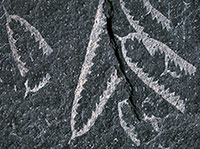End-Ordovician mass extinction
Many experts believe the extinction event at the end of the Ordovician Period was the second most severe of the great extinctions.
Virtually all life was in the sea at this time so it was mostly marine animals that were affected.
When did it happen?

Fossil of a 'tuning fork' graptolite, Didymograptus. Some of these colonial marine animals were victims of the end-Ordovician mass extinction.
Around 445-440 million years ago, possibly in 2 phases.
What went extinct?
26% of all marine families, 60% of all genera, an estimated 82-88% of all species.
Although no major groups were completely lost, many sea creatures suffered substantial losses. These included nautiloids (cousins of today's squid and cuttlefish), which were the top marine predators of the time, as well as brachiopods, corals, bryozoans, echinoderms, graptolites and eel-like conodonts. Over 90% of trilobite species disappeared.
Causes

As large ice sheets formed in the Late Ordovician, sea levels fell dramatically, draining inland seas.
At the end of the Ordovician Period, the world entered an intense ice age, possibly brought about by the location of the supercontinent Gondwana over the southern pole.
The formation of large ice sheets meant sea levels fell dramatically, perhaps by as much as 70-100m. This particularly affected the corals and bryozoans that were living in shallow inland seas, which drained of water. Global cooling spelt disaster for warm-adapted species that had nowhere to migrate to.
Then, after about 1 million years, the glacial conditions ended rapidly. Sea levels rose, water low in oxygen blanketed the shallow marine habitats, and deep ocean waters stagnated, delivering a second blow to the marine life that had managed to survive.
Find out how life recovered and when the next mass extinction hit
Toolbox
The Great Extinctions book

What are the processes responsible for species extinction? And are we about to cause another mass extinction? Find out in this in-depth guide by Museum expert, Professor Norman MacLeod.
